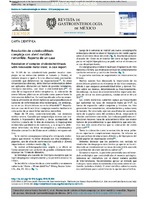Repositorio Digital
Resolución de coledocolitiasis compleja con stent metálico removible. Reporte de un caso
- DSpace Principal
- →
- Hospital El Cruce
- →
- Publicaciones
- →
- Artículos
- →
- Ver ítem
JavaScript is disabled for your browser. Some features of this site may not work without it.
Mostrar el registro sencillo del ítem
| dc.contributor.author | Curvale, Cecilia | |
| dc.contributor.author | Guidi, Martín | |
| dc.contributor.author | Hwang, Hui Jer | |
| dc.contributor.author | De María, Julio | |
| dc.contributor.author | Matanó, Raúl | |
| dc.date.accessioned | 2016-02-18T18:35:06Z | |
| dc.date.available | 2016-02-18T18:35:06Z | |
| dc.date.issued | 2015 | |
| dc.identifier.citation | Curvale C, Guidi M, Hwang H, De Maria J, Matanó R. Resolución de coledocolitiasis compleja con stent metálico removible. Reporte de un caso. Revista de Gastroenterología de México. 2015 | es_AR |
| dc.identifier.issn | 0375-0906 | |
| dc.identifier.uri | http://hdl.handle.net/123456789/225 | |
| dc.description | Fil: Curvale, C. Hospital de Alta Complejidad en Red El Cruce Dr. Néstor C. Kirchner. Servicio de Gastroenterología. Florencio Varela, Argentina. | es_AR |
| dc.description.abstract | Extraction can turn out to be complex in 15-20% of choledochal stones due to size (> 15 mm), number (≥ 3), or the container-content dissociations determining impactions. Under these adverse circumstances, other endoscopic techniques should be applied: large-volume balloon dilation or mechanical, laser, or electrohydraulic lithotripsy. If therapeutic success is not achieved, the placement of plastic biliary stents is employed as a bridge until definitive intervention. Over the last decade, the useof self-expanding metal stents in the context of benign biliary pathology has increased, but their role in treating biliary stones has not been described.6---8We present herein the case of complex bile duct stones resolved through the placement of a removable metallic biliary stent. | es_AR |
| dc.language.iso | en | es_AR |
| dc.subject | Coledocolitiasis | es_AR |
| dc.subject | Cateterismo | es_AR |
| dc.title | Resolución de coledocolitiasis compleja con stent metálico removible. Reporte de un caso | es_AR |
| dc.title.alternative | Resolution of complex choledocholithiasis with removable metal stent. A case report | es_AR |
| dc.type | Article | es_AR |
Ficheros en el ítem
Este ítem aparece en la(s) siguiente(s) colección(ones)
-
Artículos
Articles

